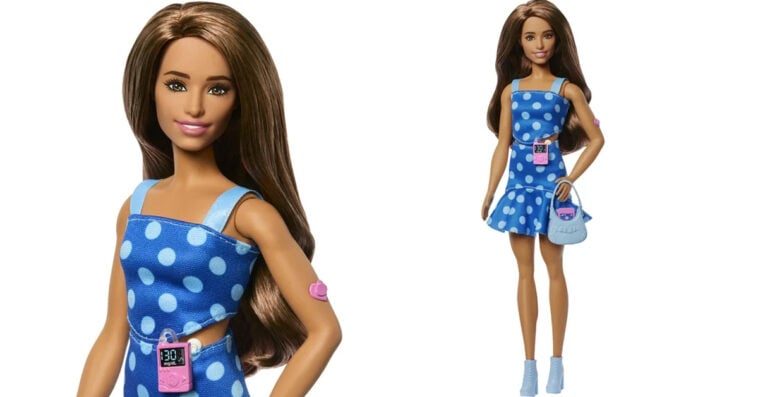Barbie is taking another step toward inclusivity by releasing a doll with type 1 diabetes (T1D). The release of this doll goes beyond style; it’s a thoughtful step toward greater inclusivity in the toy aisle. With features that many kids living with the condition will recognize, this doll helps normalize their experiences and offers a chance to feel seen and represented in everyday play.
Barbie Adds First-Ever Doll with Type 1 Diabetes to Fashionistas Line
Barbie is expanding its Fashionistas line with a groundbreaking new release: a doll that represents life with type 1 diabetes. This meaningful addition not only helps more children see themselves in Barbie, but also encourages play that fosters empathy and understanding, which are core values of the Barbie brand.
To ensure authenticity in both design and messaging, Barbie collaborated with Breakthrough T1D (formerly known as JDRF), the world’s leading organization focused on type 1 diabetes research and advocacy. Type 1 diabetes (T1D) is a chronic autoimmune condition where the body produces little or no insulin, requiring lifelong management and carrying potential complications. With input from Breakthrough T1D, Barbie carefully developed a doll that accurately reflects the realities of living with the condition, including the medical devices many children use every day.
The new doll features a continuous glucose monitor (CGM) worn on her arm, secured with heart-shaped medical tape in Barbie’s signature pink. A smartphone accessory shows a CGM app interface, highlighting how many people track their blood sugar in real time. At her waist, the doll wears an insulin pump—a small device that delivers automated insulin doses as needed. She’s dressed in a blue polka dot top and matching ruffled skirt, a stylish look that also serves as a nod to the global symbols of diabetes awareness. Completing the ensemble is a pastel blue purse, a playful yet practical touch that represents how people living with T1D often carry essential supplies or snacks on the go.
“Introducing a Barbie doll with type 1 diabetes marks an important step in our commitment to inclusivity and representation,” said Krista Berger, Senior Vice President of Barbie and Global Head of Dolls. “Barbie helps shape children’s early perceptions of the world, and by reflecting medical conditions like T1D, we ensure more kids can see themselves in the stories they imagine and the dolls they love.”
The collaboration is especially personal for Breakthrough T1D’s CEO, Dr. Aaron J. Kowalski, who has firsthand experience living with the condition.
“We were thrilled when Barbie approached us to collaborate on the development of the Barbie doll with type 1 diabetes,” said Kowalski. “I have lived with T1D since I was 13, and my brother since he was 3, so this partnership is deeply personal – it means the world to be part of bringing greater visibility to a condition that affects so many families. It’s an honor to work with a brand that shares our commitment to showing children that a life with type 1 diabetes can be full, vibrant, and empowering.”
Barbie Celebrates Diabetes Doll Debut with Donations and Role Model Recognition
Ahead of the July 8 release of the Barbie doll with type 1 diabetes, the brand continued its partnership with Breakthrough T1D by donating dolls to the 2025 Breakthrough T1D Children’s Congress. Held from July 7–9 in Washington, D.C., this biennial event brings together 170 youth delegates—children ages 4 to 17 who are living with type 1 diabetes—from all 50 U.S. states as well as Breakthrough T1D’s international affiliates in the United Kingdom, Australia, Israel, the Netherlands, and Canada. The children gather in the nation’s capital to meet directly with members of Congress, advocating for research and raising awareness of life with T1D.
As part of its ongoing celebration of advocacy and representation, Barbie also honored two global role models known for their work in raising awareness of type 1 diabetes. Peloton instructor Robin Arzón in the United States and model Lila Moss in the United Kingdom were each recognized with their own one-of-a-kind Barbie dolls, custom-designed to reflect their achievements and contributions as T1D advocates on the world stage.
How to Get the Barbie Doll with Type 1 Diabetes
The full 2025 Barbie Fashionistas collection, which includes the groundbreaking Barbie doll with Type 1 diabetes, is now available for purchase. You can find these dolls on the Mattel Shop website and at major retailers across the country. Specifically, the Barbie doll featuring Type 1 diabetes is available at Amazon and Walmart for $10.99.
The Ever-Expanding Barbie Fashionistas Line
The Barbie Fashionistas line continues to expand its commitment to diversity and inclusion. In addition to the new doll with type 1 diabetes, the collection features over 175 unique looks that celebrate a wide range of representation. These dolls reflect a variety of skin tones, eye colors, hair colors and textures, body types, disabilities, and personal styles. Among the inclusive offerings are a Barbie doll with a visual impairment, a doll with Down syndrome, and one with hearing aids—each thoughtfully designed to help more children see themselves in the toys they play with.

